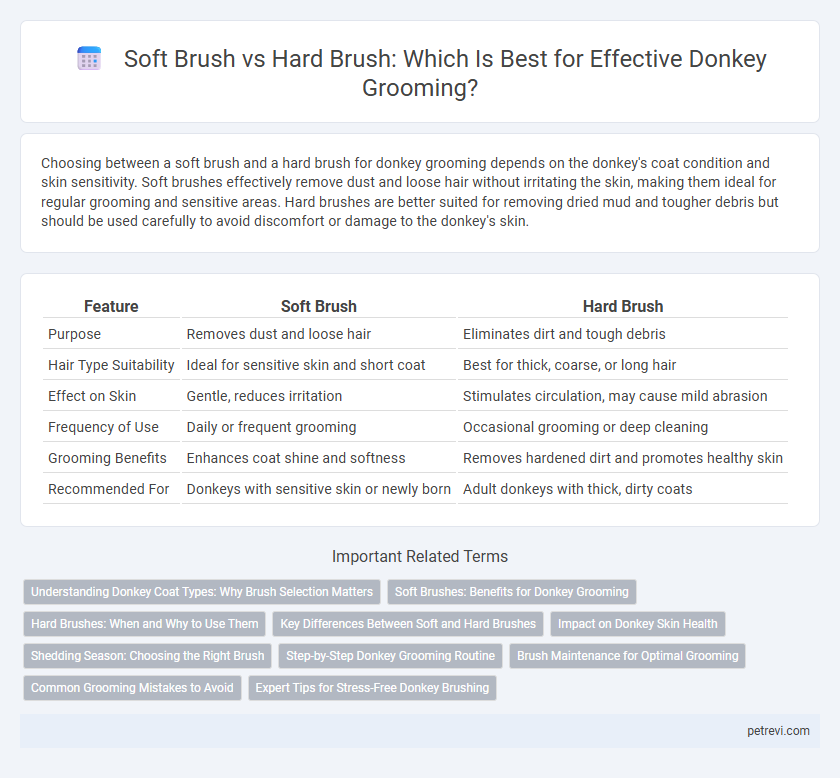Choosing between a soft brush and a hard brush for donkey grooming depends on the donkey's coat condition and skin sensitivity. Soft brushes effectively remove dust and loose hair without irritating the skin, making them ideal for regular grooming and sensitive areas. Hard brushes are better suited for removing dried mud and tougher debris but should be used carefully to avoid discomfort or damage to the donkey's skin.
Table of Comparison
| Feature | Soft Brush | Hard Brush |
|---|---|---|
| Purpose | Removes dust and loose hair | Eliminates dirt and tough debris |
| Hair Type Suitability | Ideal for sensitive skin and short coat | Best for thick, coarse, or long hair |
| Effect on Skin | Gentle, reduces irritation | Stimulates circulation, may cause mild abrasion |
| Frequency of Use | Daily or frequent grooming | Occasional grooming or deep cleaning |
| Grooming Benefits | Enhances coat shine and softness | Removes hardened dirt and promotes healthy skin |
| Recommended For | Donkeys with sensitive skin or newly born | Adult donkeys with thick, dirty coats |
Understanding Donkey Coat Types: Why Brush Selection Matters
Donkey coat types vary significantly, from short, smooth hair to long, coarse hair, influencing the choice between soft and hard brushes for effective grooming. Soft brushes are ideal for donkeys with sensitive skin or shorter coats, ensuring gentle removal of dust and loose hair while preventing irritation. Hard brushes suit thicker, wiry coats, efficiently dislodging dirt and debris from dense hair to maintain skin health and promote circulation.
Soft Brushes: Benefits for Donkey Grooming
Soft brushes are ideal for donkey grooming as they effectively remove loose hair and dirt without irritating the sensitive skin. Their gentle bristles stimulate blood circulation and promote healthy coat growth while providing a soothing grooming experience. Regular use of soft brushes helps maintain skin health and enhances the donkey's comfort during grooming sessions.
Hard Brushes: When and Why to Use Them
Hard brushes are essential for removing stubborn dirt and dried mud from a donkey's coat, especially in colder months when the hair is thicker. They help stimulate blood circulation and promote a healthy skin condition by exfoliating dead skin cells effectively. Using hard brushes strategically reduces the risk of skin irritations and keeps the donkey's coat looking clean and well-maintained.
Key Differences Between Soft and Hard Brushes
Soft brushes for donkey grooming gently remove dust and loose hair while being sensitive to the animal's delicate skin, making them ideal for daily grooming and sensitive areas like the face and ears. Hard brushes have stiffer bristles designed to dislodge dirt, sweat, and dried mud from thicker coats and are better suited for deep cleaning during seasonal shedding or after outdoor activities. The key difference lies in bristle stiffness and intended use: soft brushes prioritize comfort and skin care, while hard brushes provide effective cleaning and coat maintenance.
Impact on Donkey Skin Health
Soft brushes are ideal for donkey grooming as they gently remove dirt and loose hair without irritating the sensitive skin, reducing the risk of abrasions and maintaining healthy coat condition. Hard brushes can cause microtears and skin irritation, potentially leading to discomfort, inflammation, or allergic reactions in donkeys, especially those with delicate or thin skin. Regular use of soft brushes promotes better circulation and natural oil distribution, supporting overall skin health and a shiny, resilient coat.
Shedding Season: Choosing the Right Brush
During shedding season, selecting the right brush for donkey grooming is crucial to effectively remove loose hair and prevent skin irritation. Soft brushes gently eliminate fine hairs and dirt while maintaining skin health, whereas hard brushes are more aggressive, better suited for stubborn shedding but may cause discomfort if used improperly. Prioritizing a soft brush during the initial phase of shedding helps prepare the coat before transitioning to a hard brush for deeper grooming sessions.
Step-by-Step Donkey Grooming Routine
Start donkey grooming with a soft brush to gently remove dust and dirt from the coat, minimizing skin irritation and promoting comfort. Follow with a hard brush to effectively dislodge dried mud, loose hair, and debris, enhancing coat cleanliness and skin health. Finish by using a curry comb to stimulate circulation and distribute natural oils, resulting in a shiny, healthy coat.
Brush Maintenance for Optimal Grooming
Soft brushes help remove loose hair and dirt gently, preventing skin irritation in donkeys, while hard brushes effectively dislodge dried mud and debris from the coat. Maintaining brushes involves regular cleaning by removing hair buildup and washing with mild soap to prevent bacterial growth, ensuring optimal grooming performance. Proper brush care extends tool lifespan and promotes healthy donkey skin and coat condition.
Common Grooming Mistakes to Avoid
Using a soft brush on donkeys helps prevent skin irritation and respects their sensitive coat, while a hard brush can cause discomfort and damage their hair follicles. Common grooming mistakes include applying excessive pressure with hard brushes and neglecting to clean the brushes regularly, which leads to dirt buildup and potential skin infections. Consistent gentle grooming with appropriate tools promotes healthy skin, removes dirt effectively, and improves overall coat condition.
Expert Tips for Stress-Free Donkey Brushing
Selecting a soft brush for donkey grooming minimizes skin irritation and promotes relaxation by gently removing dirt and loose hair. Hard brushes, while effective for deep cleaning and stimulating circulation, should be used cautiously to avoid causing stress or discomfort. Experts recommend starting grooming sessions with a soft brush to build trust, then gradually incorporating a hard brush on tougher areas for a stress-free experience.
Soft Brush vs Hard Brush for Donkey Grooming Infographic

 petrevi.com
petrevi.com